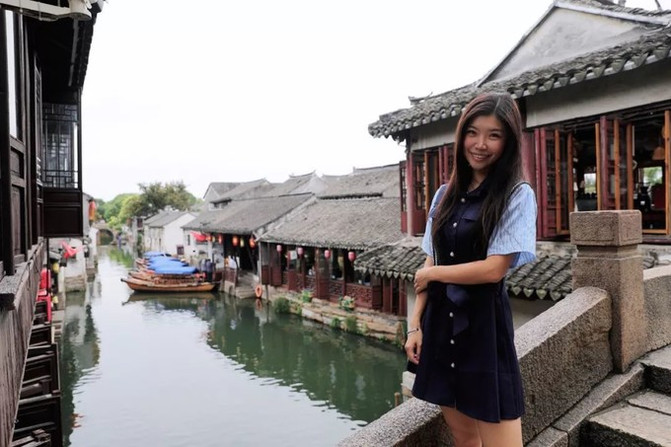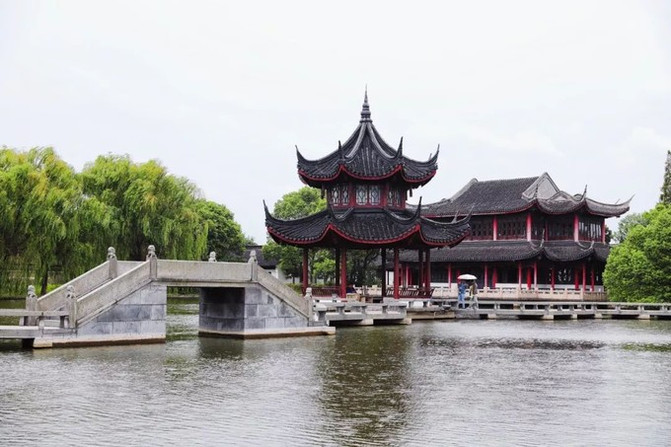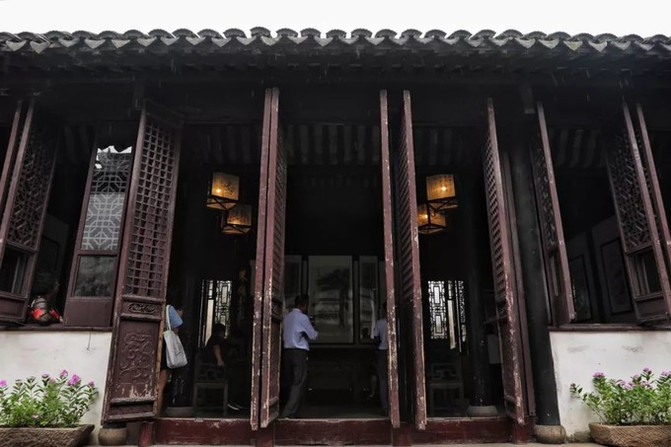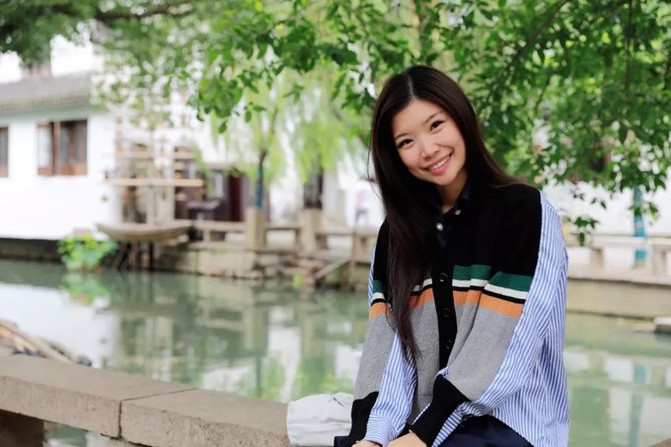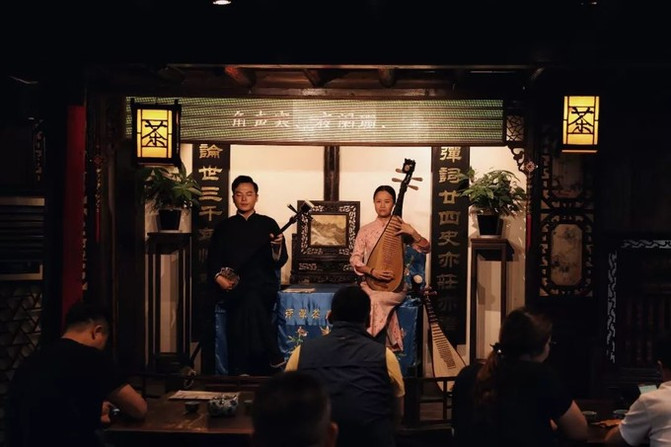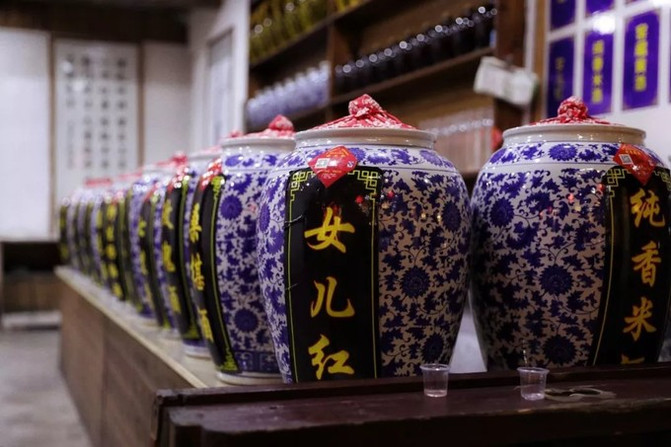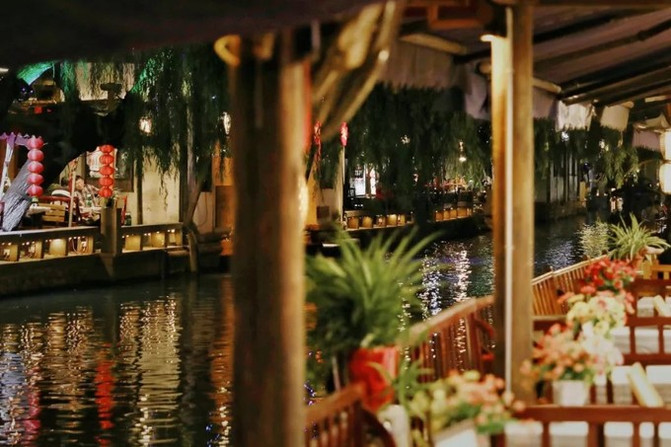Zhouzhuang, Jiangnan, is surrounded by the water, with infinite ancient charm and tenderness. Leaning on the bridge and looking into the distance, it is full of white walls, black tiles and bluestone.
The water has a long charm, and in Zhouzhuang, time will involuntarily slow down. You might as well walk into the depths of the water town to find a gentle Jiangnan dream with willows and green waves and boatlady singing a cappella.
shuangqiao
Yong 'an Bridge and Shide Bridge in the center of Zhouzhuang Ancient Town are collectively called Shuangqiao. They were built during the Wanli Period of the Ming Dynasty. Because the bridge holes are connected at right angles, they are shaped like an ancient Chinese key, also known as the Key Bridge.
In the early 1980s, the oil painting "Memories of Hometown" written by Mr. Chen Yifei, a painter living in the United States, with the theme of "Shuangqiao", was collected by the American oil magnate Hamer and presented to the Chinese leader Mr. Deng Xiaoping. It was selected as the first day cover by the United Nations. From then on, Shuangqiao has become a carrier of history and culture and a symbol of beauty in the Jiangnan water town. Zhouzhuang has also gone to the world as a representative of the Jiangnan water town.
Taking a photo in front of Shuangqiao is one of the must-check check-ins to Zhouzhuang ~ Fu 'an Bridge
Fu 'an Bridge, which spans the Nanbei River and runs through Nanbei Street, was originally known as Zongguan Bridge and was rebuilt in the Qing Dynasty. According to folklore, Shen Wansan's younger brother Shen Wansi once invested in repairs. He did not want to repeat the mistakes of Shen Wansan who was "rich enough to rival the enemy" and was sent to exile and died in a foreign country. Therefore, he named the bridge "Fu 'an" and prayed for wealth and tranquility.
Among the ancient towns, Fu 'an Bridge is the unique building with the most perfect combination of bridges and buildings. There are bridges at the four corners of the bridge body, which are pulled up against the waves and facing each other in a distance. Among the buildings in the Jiangnan water town, ancient bridges with bridges built and preserved intact are very rare.
Walking up Fu 'an Bridge, or resting on the bridge building to sip tea and enjoy the scenery, or overlooking the water town picture of small bridges and flowing water people, it is particularly poetic and quaint.
Nanhu Qiuyue Garden, Quanfu Changqiao, Quanfu Temple
The largest attraction in Zhouzhuang is Nanhu Garden at the southernmost tip of the ancient town.
There are many cultural sites in the garden, including the "Liu Bin Guest House" in memory of Liu Yuxi, a literary hero of the Tang Dynasty, the "Si Bi Resign" in memory of Zhang Han of the Jin Dynasty, and the "Feng Yuantang" built in Qingnian. Near the lake, there are many essence of Jiangnan landscape garden buildings such as Wanghu Tower, Lake Center Pavilion, Jiuqu Bridge, Lingbo Stone Boat, etc.
The Quanfu Long Bridge, which lies on the South Lake like a long dragon, has a total length of 235 meters and a total of 43 arched bridge holes. The slender jade-white bridge body contrasts with the reflection in the lake. In my spare time, boating on the lake, all my troubles are eliminated.
Quanfu Temple on the south bank has been built for more than 900 years. The entire temple has a strict structure, with water scenery, and majestic temples. It has been a famous temple in the south of the Yangtze River for generations.
South Lake Autumn Moon, Quanfu Late Bell, Zhigui Spring Outlook, Zhuangtian Falling Goose, Changsheng Ancient Apricots, and Quanfu Long Bridge are known as the "Scenic Scenery of Zhouzhuang Nanhu Garden".
The ancient town retains nearly a hundred courtyard buildings in the Ming and Qing Dynasties and more than 60 brick gate buildings. Among them, Shenting and Zhangting are the most famous representatives of residential buildings.
Shen Hall, Shen Wansan Yuanju, Wan Sanshui Tomb
On Nanshi Street in the ancient town, the Shen Hall facing east and west was built by Shen Benren, a descendant of Shen Wansan, a wealthy man in Jiangnan, in the seventh year of Qianlong of the Qing Dynasty. It covers an area of more than 2,000 square meters and has more than 100 houses.
The building is a seven-entry and five-gate building. In front of the hall is a unique dock for docking ships in the water town. The middle part is composed of wall doors, tea hall and main hall. The rear part is a living hall and hall. The hall beams and brick carved gate buildings are cleverly conceived and beautifully depicted.
The whole building combines the strengths of the Hui Gang, Shao Gang and Su Gang, and is magnificent. You can see traces of time here.
On the east side of the ancient town, there are Shen Wansan Garden Residence and Wan Sanshui Tombs. You can also stroll around.
Zhangting
Zhang Hall, built by the descendants of Xu Kui, the younger brother of Xu Da, King Sun Yat-sen in the early 14th century, was originally named Yishun Hall. In the early 16th century, it was owned by the surname Zhang, commonly known as Zhang Hall.
The entire antique building complex has six entrances to the front and back, facing the street along the river. There are more than 70 houses of different sizes, and a 47-meter long alley from the main hall to the back garden. The Zhujing River passes through the houses, with the unique scenery of the water town that "the sedan chair enters through the front door and the boat passes through the home."
ancient stage
Inside the brick gate building, the stage in the courtyard sits south to north. There are flying eaves and angled corners, phoenix caissons, carved beams and painted buildings, and it is magnificent.
On the ancient stage, professionals performed masterpieces such as Kunqu Opera "The Peony Pavilion" and "Temple of Longevity", the ancestors of hundreds of operas.
You can also walk into the ancient stage to see the few stories about traditional folk arts, the opera costumes on display, and cultural and creative souvenirs that integrate tradition and modernity.
Yifei Zhijia
Zhouzhuang is not a dream, its story was drawn by Mr. Chen Yifei.
In order to permanently commemorate Chen Yifei's contributions and friendship, the people of Zhouzhuang established the "Yifei Home" and opened it to the outside world to promote his artistic spirit.
The furnishings here include the books he loved to read during his lifetime, the brushes he used, precious manuscripts, and the European fireplace he loved.
Chengxu Taoist Temple, commonly known as the "Holy Hall", has a history of more than 900 years. It is one of the well-known Taoist temples in Wuzhong area. The main buildings in the courtyard include Yuhuang Pavilion, Wenchang Pavilion, Shengdi Pavilion, etc.
Zhouzhuang Museum Zhouzhuang Museum is located in a private ancient house with a quiet environment, displaying Zhouzhuang's long history, culture and diverse customs.
Zhenfeng Culture Street
In the Rengu House, the twelve workshops on Zhenfeng Cultural Street have traditional craft shops such as Su Embroidery Art House, Tofu Shop, Shoe Art Shop, Bamboo Workshop, Nuclear Carving Shop, Wine Workshop, Soil Cloth Workshop, and Xi Art Shop.
The passage of time has not erased the original tradition, but has made it more precious.
If you want to stop and take a nap, you can lean on the railing and empty away, or sip tea by the river, or listen to Pingtan in Jubin Tower, go to Sanmao Tea House to read the story of Sanmao and Zhouzhuang, or buy cultural and creative souvenirs in the Cat's Sky City.
Those who like to taste wine and tea can also try Wansan Yellow Wine, Osmanthus Brewed, and Apo Tea.
The rowing boat swamps through every nameless street and alley, between the water, bridge and house. The dense water vapor is elegant and peaceful, and even the cat has some low-brow gentleness.
Zhouzhuang's cruise ship can have four different experiences: the water around the town and the upstream reaches of the countryside in the south of the Yangtze River, the water alley tour of the ancient town where Wunong's soft language crosses the bridge and enters the alleys, the Wansan Water Wealth Road to find wealth and visit the ancient times, and the night tour of Zhouzhuang under the sound of oars and the shadow of lights. Choose the waterway and the water town to embrace each other at zero distance, and the gentleness is the most soft and crispy to the bone.
The night is quiet and the lights are shining, and the ancient town is full of beautiful scenery.
Quangong Bridge is a brick bridge in the ancient town that spans the north and south Shihe River in the east-west direction. There are couplets on the pillars on both sides of the bridge. The north link reads "The north is surrounded by rapid water and springs, and the west controls remote mountains and earth veins", and the south link reads "Fishing songs on the river and Listening to the moon, the sails on the sun bring the clouds back", the two couplets vividly demonstrate Zhouzhuang's excellent geographical location and the comfort and charm of the ancient town. Entering the ancient town from the Quangong Bridge, there are many waterside restaurants. If you take a photo of the moonlit figures in Xiashui Township, the ancient town of Jiangnan has a fireworks atmosphere.


Xianjiang Bay and Nanhu Bay will stage grand light and shadow shows at night. Xianjiang Bay is covered with colorful water curtains, and the light and shadow show of "Xianjiang Fishing Singing" shows the fishing flavor of the water town.
The Nanhu Bay Light and Shadow Show revolves around the beautiful scenery of "South Lake Autumn Moon","Dongzhuang Snow","Zhuangtian Falling Goose" and other beautiful scenery in the "Eight Scenes of Zhouzhuang". It uses flowing fountains, water curtains, and water walls to present the bright moon in the sky, heavy snow, and the return of falling geese. Many poetic and beautiful pictures. The shocking performance is the most beautiful night picture in Nanhu Bay.
From April to November every year, you can watch "Four Seasons Zhouzhuang", China's first live performance in a water town that presents the original ecological culture of Jiangnan. The performance takes place in a classic environment of "small bridges, flowing water, and people's homes". The painting is grand and is a first-class performance with a high level of folk custom, ornamental and artistic nature. Let's start here after a night of knowing Jiangnan.

Old Mr. Wu Guanzhong said,"Huangshan embodies the beauty of China's mountains and rivers, and Zhouzhuang embodies the beauty of China's water towns." Yu Qiuyu once wrote,"The mottled green and gray color is like a residual dream in the morning, and the intertwined double bridges are firm and old. There is no picture that can better summarize the Jiangnan town, and there is nothing like this Jiangnan town to symbolize the homeland." Sanmao said,"I want to come to Zhouzhuang to eat grandma tea and hairy crabs, and I have to see it in the streets and alleys of my homeland."
Everyone says that Zhouzhuang is like a dream. I hope to say good night in Zhouzhuang and enlighten me to dream of Jiangnan.
(The photo in this article is authorized by photographer He Wenbin)








